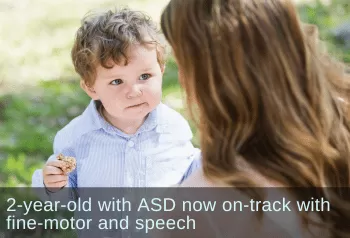Primitive Reflex Integration Case Studies
2-Year-Old with ASD Develops Eye Contact, Fine-Motor Skills, and Babbling
Rhythmic movements help toddler with ASD.
Before starting therapy with rhythmic movements, this little boy with ASD displayed very little eye contact, was non-verbal, preferred to play alone, had trouble getting to sleep, and had delayed fine-motor skills. Find out how these simple yet powerful movements helped get him on track.
Submitted by Mary Bessenbacher, Occupational Therapist

| Before | After |
|---|---|
| Very little eye contact | Occasional eye contact |
| Non-verbal | Has begun to babble |
| Trouble getting to sleep | More relaxed at night |
| Delayed fine-motor skills | Can place shapes into a shape sorter with minimal assistance |
Cash is a 2 year old boy diagnosed with autism that I work with in his home on a weekly basis. He displays very little eye contact, is non-verbal, prefers to play alone, and has trouble getting to sleep. He is delayed in fine-motor skills and prefers vestibular activities such as swinging, jumping, and rocking on the exercise ball. Often, he would cry when I arrived and would attempt to run to the other room.
I began introducing the rhythmic movements [from the Brain and Sensory Foundations First Level course] with Cash because his delays in motor skills could likely be due to retained primitive reflexes. (Testing for them individually was not possible due to non-compliance.) He laid still for the first rhythmic movement for almost one minute the first time I did it. His mom was in disbelief because he usually does not allow touch unless it is something he seeks out on his own. I also got eye contact during this movement. He did not lie still for the other three during our sessions. I did teach them to mom and told her to use them throughout the day and at bedtime.
Mom has used the rhythmic movements before bed and said that it helps him to lie still and relax. He especially likes the second one, lying on his side. I have noticed more compliance in our sessions since I have started the rhythmic movements. Some days he will not allow me to do them, but I have found that if I roll him on his back on the therapy ball for several minutes and then try to do the movements, he is more compliant. Since we have started, he has begun to babble, place shapes into a shape sorter with minimal assistance, clap his hands in imitation, and look at books with an adult. He was doing none of these skills a few months ago.
[Edited for length and clarity; emphasis added]
*Disclaimer: The activities in the Brain and Sensory Foundations curriculum make use of the natural processes of neuroplasticity and development that are innately wired in the design of human beings to promote maturity and function. These activities appear to calm, organize, and mature the neuro-sensory-motor systems just as we see in the healthy development of human infants. Individual results may vary, and we do not claim to offer a diagnosis or cure for any specific condition or disorder. The Brain and Sensory Foundations activities appear to improve overall functioning resulting in measurable improvements for a range of conditions as demonstrated in over 1800 case studies from participants.

